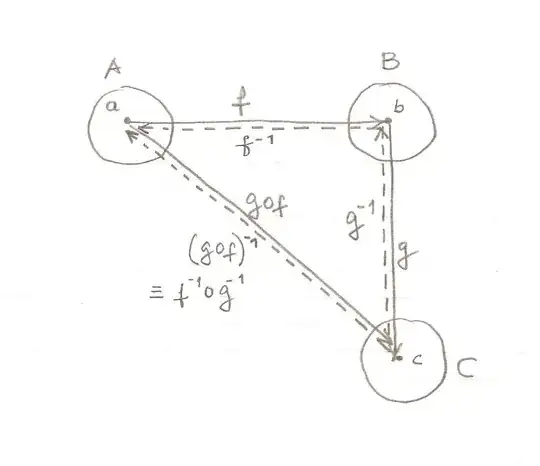I am stuck with this question,
Let $A=B=C=\mathbb{R}$ and consider the functions $f\colon A\to B$ and $g\colon B\to C$ defined by $f(a)=2a+1$, $g(b)=b/3$. Verify Theorem 3(b): $(g\circ f)^{-1}=f^{-1}\circ g^{-1}.$
I have calculated $f^{-1}$, $g^{-1}$, and their composition, but how do I find the inverse of $(g\circ f)$?
Here is how I have done so far,
$$\begin{align*} \text{Let}\qquad\qquad b &= f(a)\\ a&= f^{-1}(b)\\ &{ }\\ b&=f(a)\\ b&=2a+1\\ \frac{b-1}{2} &= a\\ a &= \frac{b-1}{2} \end{align*}$$ But $a=f^{-1}(b)$, $$f^{-1}(b) = \frac{b-1}{2}.$$
${}$
$$\begin{align*} \text{Let}\qquad\qquad a&=g(b)\\ b&= g^{-1}(a)\\ a&= g(b)\\ a &= b/3\\ b &= 3a\\ g^{-1}(a) &= 3a\qquad(\text{because }b=g^{-1}(a) \end{align*}$$
${}$
$$\begin{align*} f^{-1}\circ g^{-1} &= ?\\ &= f^{-1}\Bigl( g^{-1}(a)\Bigr)\\ &= f^{-1}(3a)\\ f^{-1}\circ g^{-1} &= \frac{3a-1}{2} \end{align*}$$
$$\begin{align*} g\circ f&= g\bigl(f(a)\bigr)\\ &= g(2a+1)\\ g\circ f &= \frac{2a+1}{3}\\ (g\circ f)^{-1} &= ?\\ \text{Let}\qquad\qquad &b=g\circ f \end{align*}$$
EDIT:
Thanks for the answers, I followed the suggestions and came up with the answer,

 Now I have two questions,
Now I have two questions,
- The answers do match but the arguments are different. Is that ok?
- Is $(g\circ f)$ same as $(g\circ f(a))$?
